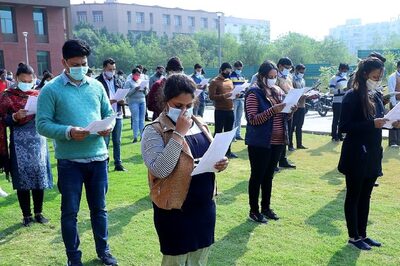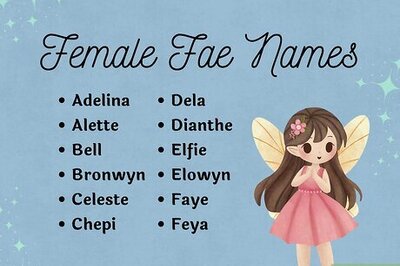
views
‘The Mother of Modern Feminism’, the ‘First Female Teacher of India’ and more – she was Savitri Bai Phule, a women who broke gender and caste barriers to herald a new age through her life of activism and education.
On her 192nd birth anniversary, News18 takes a look at her life:
Born in Naigaon, Maharashtra
Savitribai Phule was born on January 3, 1831 in Naigaon, Satara District, Maharashtra. Her birthplace was about fifteen kilometres (9.3 miles) from Shirval and about fifty kilometres (31 miles) from Pune.
Phule was the youngest daughter of Mali community members Lakshmi and Khandoji Nevase Patil. She had three brothers and sisters.
Savitribai married Jyotirao Phule when she was 9 or 10 years old (he was 13). Savitribai and Jyotirao did not have any children. They are said to have adopted Yashawantrao, the son of a Brahmin widow, reports say.
When Yashwant was about to marry, no one wanted to give him a girl because he was born to a widow. As a result, in February 1889, Savitribai arranged his marriage to the daughter of her organization’s worker Dynoba Sasane.
Education and an Incident that Changed Her Life
According to a report by Jagran Josh, Savitribai found her way to education thanks to her forward-thinking husband, Jyotiba Phule, who strongly believed in female education to eliminate social inequalities. Jyotiba taught Savitribai Phule at their home.
Savitribai was a child when her father caught her red-handed pulling the pages of an English language book. He snatched the book from her grasp and tossed it far away, instructing her never to touch another one again. In those days, it was thought that only men from privileged castes had the right to study. Savitribai vowed that day to learn to read and write regardless of what happened.
After marriage, Jyotiba Phule enrolled her in a teacher training programme at a training institute in Pune. She actually enrolled in two teacher training programmes, one in Ahmednagar with American missionary Cynthia Farrar and one in Pune. Savitri went on to become the first woman headmistress of any school in India, as well as the country’s first female teacher. In Maharashtra, her birthday is also known as Balika Din.
Divya Kandukuri, in a report titled ‘the Life and Times of Savitri Phule’ in Mint, wrote, “It is important to understand the milieu in which the young Savitri grew up. Public education was yet to emerge and there were only a few missionary schools which were “open to all”. Brahmins were the only caste group that received an education and could take a lead in setting up schools. This was the context in which Jyotiba, at the age of 21, and Savitri, 17, opened a school for women in 1848. It was the country’s first school for women started by Indians.”
Later, Savitribai and Jyotirao founded an education society in 1853, which opened more schools for girls and women of all classes in surrounding villages.
‘Would Carry an Extra Saree as People Would Throw Dung on Her’
Google Arts and Culture reports that Savitri Bai’s journey had not been easy. On her way to school, she was abused and had dung thrown at her. Savitribai simply changed into the spare saree she always carried with her and continued on her journey.
Jagran Josh mentions in their report that the privileged ‘upper’ Brahmin class in their neighbourhood harassed the Phules because they belonged to the oppressed Mali caste, despite the fact that they were educated.
They were eventually forced to leave their father’s house in 1849 after being accused of committing the sin of studying against Manusmriti and its Brahmanical texts.
She and her husband taught children from various castes and opened a total of 18 schools. They also established the Balhatya Pratibandhak Griha, a care centre for rape and pregnancy victims.
Worked for the Plight of Widows
Savitribai, moved by the plight of widows in India, founded a shelter for them in 1854. After years of reform, she paved the way for the construction of a large shelter for destitute women, widows, and child brides abandoned by their families in 1864. She educated all of them.
The oppressed classes were prohibited from drinking water from the village well. Jyotirao and Savitribai dug a well in their backyard from which they drank water. In 1868, this move sparked outrage, the report by Google Arts and Culture states.
Savitribai was instrumental in shaping Satyashodhak Samaj, The Truthseeker’s Society, Jyotirao’s brainchild. The Samaj’s main goal was to eliminate discrimination and the need for social order. In 1873, Savitribai established Satyashodhak Marriage, in which couples took an oath of education and equality.
In 1852, the British government named her the best teacher in the state. In 1853, she received additional government recognition for her work in education.
A Death in Service
In 1897, the bubonic plague swept across Maharashtra. Savitribai, never one to stand by and watch, rushed to the affected areas to assist. In Hadapsar, Pune, she established a plague clinic, the report states.
She caught the plague while carrying a 10-year-old plague victim to the clinic in her arms. Savitribai Phule passed away on March 10, 1897.
Read all the Latest Explainers here




















Comments
0 comment